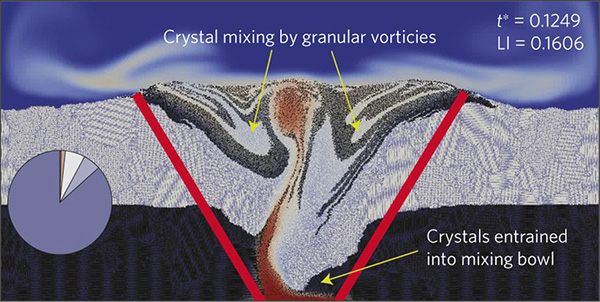
by Lance Newman Wednesday, December 16, 2015

Researchers have adapted a computer model originally developed to simulate fuel combustion to study the dyanamics of magma mixing in volcanic magma chambers. In this snapshot, hot mantle material injected into a chamber (orange) mixes with cooler liquid magma (blue) and solid crystals (black) already in the chamber. Credit: George Bergantz/University of Washington
Volcanic eruptions can spew large amounts of molten rock and ash, putting nearby communities as well as aircraft at risk. Gas emissions and earthquakes sometimes offer clues of when an eruption will occur, but the internal workings of volcanoes are largely unobservable. In a recent study, researchers illuminated these internal processes with a computer simulation that models the flow of the part-liquid, part-solid “magma mush” beneath volcanoes.
Volcanic magmas are semi-fluid mushes of solid crystals and melted liquid rock; these mushes experience prolonged periods of slow cooling interrupted by bursts of warming when hot rock from Earth’s mantle intrudes into a magma chamber. Such intrusions can lead to rapid mixing of the cool and warm materials, and the buildup of energy before an eruption, researchers led by George Bergantz of the University of Washington wrote in Nature Geoscience. The dual nature of volcanic fluids as part molten and part solid has been known for some time, but previous modeling of magmas has not captured the same level of detail achieved in the new simulation, which may help scientists better understand how the molten material flows underground, the team noted.
The computer model the team used was adapted from one developed by the U.S. Department of Energy to model fuel combustion. Bergantz’s group had previously used it to study volcanic ash plumes, but this is the first time it has been utilized for simulations in the interior of a volcano. The model allowed the researchers to track magma movement on a very fine scale, down to the path of individual crystals. “This tool is novel because it lets us explore the mechanics” of magma, Bergantz said in a statement. “It creates an interpretive framework for what controls the movement [of magma], and what might produce the signals we see on the outside.”
In the study, Bergantz and his colleagues describe a “mixing bowl” effect created when fresh, hot mantle material flows into and mixes with cool magma in a chamber beneath a volcano. The rate of intrusion of the new magma, it turns out, is key in determining how fluidized the mush becomes. The researchers looked at scenarios that considered three different magma intrusion rates, finding that the higher the rate, the more fluidized the mixing bowl became.
At the lowest intrusion rate, magma flowed through the crystal mush similarly to how a fluid, such as groundwater, moves through, but mixes little with, porous rock. In the middle scenario, the magma partially fluidized the crystal mush, and more mixing occurred. And at the highest magma intrusion rate, the entire magma chamber became fluidized and mixed almost completely.
The modeling results may help researchers studying mineral crystals in actual volcanic rocks recreate the history of the magma from which those rocks formed. These crystals often contain a layered record — similar to tree rings — of how their chemical composition changed as they grew and mixed with other materials.
In particular, the researchers plan to apply what they’ve learned from the simulations to volcanic rocks near Mauna Loa in Hawaii. “Mauna Loa is a terrific place to study because it is very active, and the rocks contain a single type of crystal,” Bergantz said. Feeding real data back into the model will increase its accuracy, allowing them to study more complex volcanoes. “What we learn at Mauna Loa will allow us to make headway on other places, like Mount St. Helens, that are intrinsically more difficult.”
“This model is an important step toward [understanding] what we’ve observed, and what simulations say we should be observing based on the laws of physics,” says Kari Cooper, a volcanologist from the University of California at Davis who was not involved with the study.
While the model currently represents only a generic magma chamber experiencing a simplified magma mixing event, with more fine-tuning it could be adapted to emulate real volcanoes, Bergantz and his colleagues wrote. Combined with analyses of actual lava samples, the model could also be used to recreate how the magma inside a volcano has changed over time. This added insight about a volcano’s past could offer a better understanding of its potential future behavior, the researchers suggested.
© 2008-2021. All rights reserved. Any copying, redistribution or retransmission of any of the contents of this service without the expressed written permission of the American Geosciences Institute is expressly prohibited. Click here for all copyright requests.